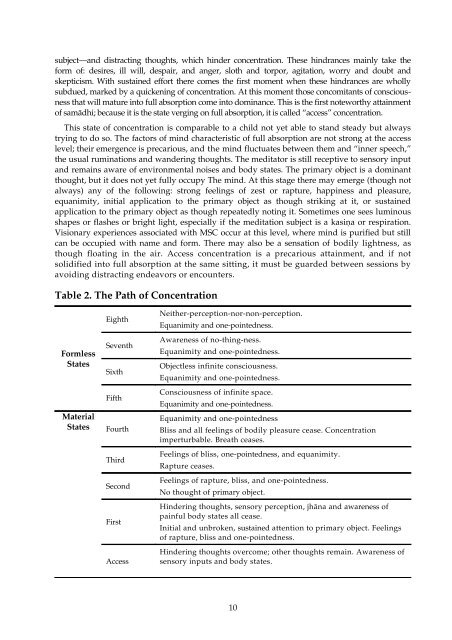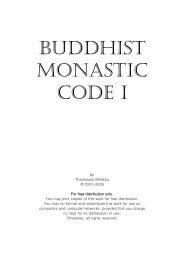THE BUDDHA W MEDITATION - Theravada Buddhism
THE BUDDHA W MEDITATION - Theravada Buddhism
THE BUDDHA W MEDITATION - Theravada Buddhism
Create successful ePaper yourself
Turn your PDF publications into a flip-book with our unique Google optimized e-Paper software.
subject—and distracting thoughts, which hinder concentration. These hindrances mainly take the<br />
form of: desires, ill will, despair, and anger, sloth and torpor, agitation, worry and doubt and<br />
skepticism. With sustained effort there comes the first moment when these hindrances are wholly<br />
subdued, marked by a quickening of concentration. At this moment those concomitants of consciousness<br />
that will mature into full absorption come into dominance. This is the first noteworthy attainment<br />
of samādhi; because it is the state verging on full absorption, it is called “access” concentration.<br />
This state of concentration is comparable to a child not yet able to stand steady but always<br />
trying to do so. The factors of mind characteristic of full absorption are not strong at the access<br />
level; their emergence is precarious, and the mind fluctuates between them and “inner speech,”<br />
the usual ruminations and wandering thoughts. The meditator is still receptive to sensory input<br />
and remains aware of environmental noises and body states. The primary object is a dominant<br />
thought, but it does not yet fully occupy The mind. At this stage there may emerge (though not<br />
always) any of the following: strong feelings of zest or rapture, happiness and pleasure,<br />
equanimity, initial application to the primary object as though striking at it, or sustained<br />
application to the primary object as though repeatedly noting it. Sometimes one sees luminous<br />
shapes or flashes or bright light, especially if the meditation subject is a kasiṇa or respiration.<br />
Visionary experiences associated with MSC occur at this level, where mind is purified but still<br />
can be occupied with name and form. There may also be a sensation of bodily lightness, as<br />
though floating in the air. Access concentration is a precarious attainment, and if not<br />
solidified into full absorption at the same sitting, it must be guarded between sessions by<br />
avoiding distracting endeavors or encounters.<br />
Table 2. The Path of Concentration<br />
Formless<br />
States<br />
Material<br />
States<br />
Eighth<br />
Seventh<br />
Sixth<br />
Fifth<br />
Fourth<br />
Third<br />
Second<br />
First<br />
Access<br />
Neither-perception-nor-non-perception.<br />
Equanimity and one-pointedness.<br />
Awareness of no-thing-ness.<br />
Equanimity and one-pointedness.<br />
Objectless infinite consciousness.<br />
Equanimity and one-pointedness.<br />
Consciousness of infinite space.<br />
Equanimity and one-pointedness.<br />
Equanimity and one-pointedness<br />
Bliss and all feelings of bodily pleasure cease. Concentration<br />
imperturbable. Breath ceases.<br />
Feelings of bliss, one-pointedness, and equanimity.<br />
Rapture ceases.<br />
Feelings of rapture, bliss, and one-pointedness.<br />
No thought of primary object.<br />
Hindering thoughts, sensory perception, jhāna and awareness of<br />
painful body states all cease.<br />
Initial and unbroken, sustained attention to primary object. Feelings<br />
of rapture, bliss and one-pointedness.<br />
Hindering thoughts overcome; other thoughts remain. Awareness of<br />
sensory inputs and body states.<br />
10






